TRS-80
The TRS-80 (Tandy Radio Shack Z-80), was the designation for several lines of microcomputer systems produced by Tandy Corporation
Also known affectionately or derisively as the “Trash-80”
Sold through their Radio Shack stores in the late 70s and 80s
Description
Announced at a press conference on February 2, 1977, the Tandy TRS-80 Model I was Tandy Corporation's entry point into the personal computer market, meaning it competed directly against the Commodore PET 2001 and the Apple II
It was released on August 3, 1977
It sold for $599 in a package that included a 12 inch black and white monitor, cassette recorder/player, and central processing unit
It was the most expensive product that Tandy's electronics store chain, Radio Shack, had ever offered
The company's management was unsure about the market attractiveness of the computer and therefore kept initial production at only 3,000 units
So that if the computer was not sold, it could be used for accounting purposes within the chain's 3,000 stores
However, its success was such that Tandy ended up selling 10,000 computers in the first month and 55,000 during the first year
Before being discontinued in January 1981, more than 250,000 units had been sold
Models
TRS-80 Model I
The TRS-80 Model I was developed for Tandy by Don French and Steve Leininger
Its keyboard was very thick compared to those that appeared on other machines since the computer's circuits were in the case itself, hidden just below the keyboard
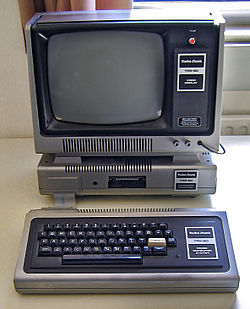
It was the first computer made that way, followed 3 years later by the VIC-20 made by Commodore
It had a Zilog Z80 microprocessor running at 1.77 MHz.
First the TRS-80 Model I Level I appeared, and soon the TRS-80 Model I Level II
The difference between these models was the BASIC interpreter that resided in a ROM memory
Both computers came with 4 KiB or 16 KiB of RAM and with or without a numeric keypad
Kits were sold to convert a computer with the BASIC Level I language to Level II
Over time the TRS-80 Model I Level II with 16 KiB of RAM became common
To expand the computer you needed to purchase an “Expansion Interface”
TRS-80 Model II
In May 1979, Tandy produced the Model II which was designed as a business computer
It was not an improvement on the Model I but a completely different system
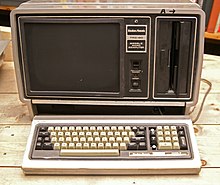
The Model II was built using the faster Z-80A chip and featured an 8 inch floppy drive as well as 64K of memory
TRS-80 Model III
Continuing improvements to the Model I, in July 1980 Tandy launched the Model III
Improvements to the Model III included the addition of lowercase letters, a better keyboard, a faster Z-80 processor, parallel, serial, and cassette ports, a built-in 16-line x 64-character (64 x 16) display, and up to two 5 1/2 inch floppy disk drives
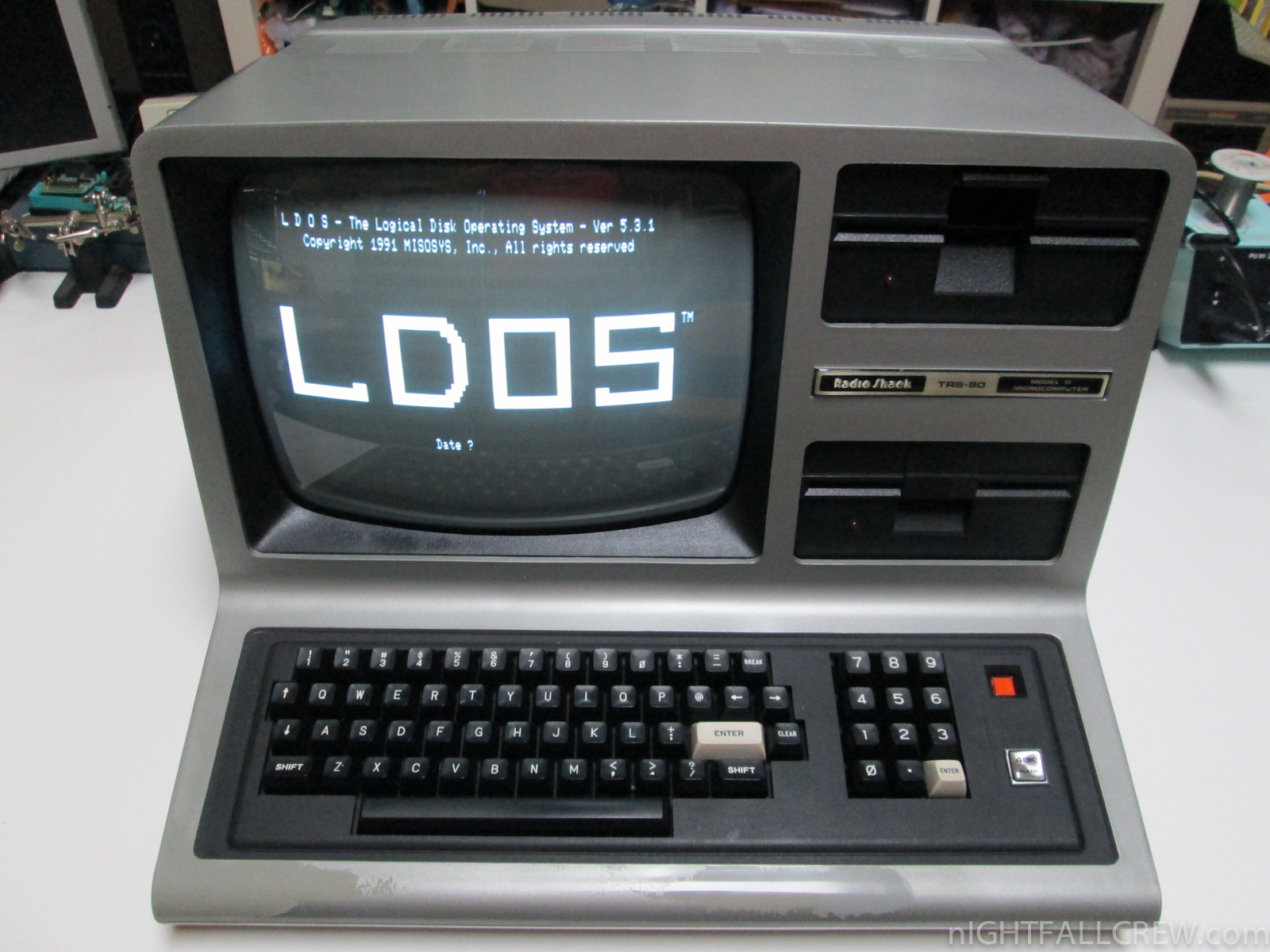
With the introduction of the Model III, production of the Model I was finally discontinued, as it did not comply with new FCC regulations regarding radio interference
In fact, the Model I radiated so much RFI (radio frequency interference) that many companies made their games in such a way that by placing an AM radio next to the computer they could use that interference to produce sounds
TRS-80 Model 4
The successor to the Model III was the Model 4 (April 1983)
It had a 4 MHz Z80 CPU, 64 KiB RAM expandable to 128, up to two 5 ¼ inch floppy drives in the same case, RS-232 serial port, parallel and cassette port, built-in 16 line by 64 character display ( 64 x 16) and also 24 lines by 80 characters (80 x 24)
Included the ability to run CP/M
Prior to Model 4, support for CP/M was only possible with a hardware modification that remapped BASIC ROMs away from memory address zero via a third-party add-on card, marketed as the Mapper board
The Model 4 also had the ability to display high resolution graphics with an optional card
This computer also came in a “luggable” version known as the Model 4P (1984)
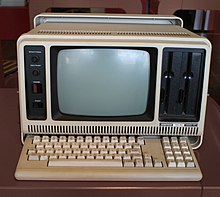
It was designed to be portable, although its size was large, it was a self-contained unit that looked like a small sewing machine
Business systems
Tandy later released the TRS-80 Model 16, which was the follow-up to the Model II
It was a UNIX-based system (Microsoft's Xenix) using the 16-bit processor (68000) plus the Z80 for compatibility with older computers
Later computers in this line were the model 12 and the model 6000
Because the business systems were designed for work and not home use, there is much less affection and nostalgia for them than for the Z-80 systems and the Color Computer (Coco)
Other systems
TRS-80 Color Computer
The TRS-80 Color Computer (Coco) was marketed by Tandy in 1980
It used a Motorola 6809 processor at 0.89 MHz
It came with 4 KiB of RAM and could be expanded up to 32 KiB of RAM
It used a version of BASIC written by Microsoft called Tandy Color BASIC that took up 8 KiB ROM
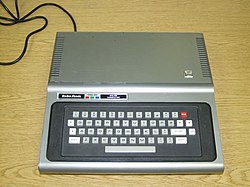
The video output was through the television screen, where 16 lines of 32 characters of text (32 x 16) were displayed in uppercase only (lowercase letters were represented with the same uppercase characters but with reverse video) and graphics up to 192 lines resolution with 256 pixels per line (256 x 192)
It had a keyboard with “chiclet” keys, so called because, unlike a normal keyboard, the keys were small rectangles that looked like Chiclets with candy coating, similar to the keys on a calculator
Later, the Color Computer 2 (1983) and Color Computer 3 (1986) were released, which had improvements over the original, including a normal keyboard, more memory, and better graphics
They were a little smaller than the original Color Computer
The Color Computer 2 came with 16 KiB RAM and was expandable up to 64 KiB, and the Color Computer 3 came with 128 KiB RAM expandable up to 512 KiB
TRS-80 MC-10
The TRS-80 MC-10 (TRS-80 Micro Color 10) was a little-known and short-lived Tandy computer (1983-1984) priced at $119.95
It was a scaled-down version of the TRS-80 Color Computer, similar in appearance and slightly larger than the Sinclair ZX81
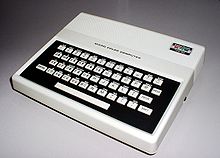
It was a small system based on the Motorola 6803 processor running at 0.89 MHz with 4 KiB RAM of memory
It had a Micro Color BASIC interpreter in 8 KiB ROM, output for TV through a radio frequency modulator with a resolution of 32 characters by 16 lines of text (32 x 16) and graphic capabilities similar to the TRS-80 Color Computer, interface RS-232 serial, cassette interface
A 16 KiB RAM expansion pack and a thermal printer were offered as an option
TRS-80 Model 100 Line
Tandy produced the TRS-80 Model 100 series, which was the first commercial line of laptop computers
Three models were produced, the models 100, 102 and 200
They had a version of the BASIC language in ROM and with a text editor program, a communications program, a contact program and a calendar
The model 200 additionally had a version of the Multiplan spreadsheet
The models 100 and 102 displayed 8 lines with 40 characters (40 x 8) and the model 200 displayed 16 lines of 40 characters (40 x 16)
These computers were very popular among journalists
The Model 100 was a joint effort between Tandy and Microsoft's Japanese division
Some sources said that this version of BASIC was the last piece of code that Bill Gates wrote commercially
TRS-80 Pocket Computer
Tandy marketed a line of pocket computers that were manufactured, depending on the model, by Sharp Corporation or Casio
They had 4 or 8-bit processors, the BASIC programming language in ROM, and some expandabilit
Several could be expanded with a printer, and a cassette recorder
Features of TRS-80 pocket calculators:
| Date | 1980 |
|---|---|
| CPU | SC43177 and SC43178 (4 bit) |
| RAM | 1.5 KiB? |
| ROM | 11 KiB? |
| Programming | BASIC |
| Screen | LCD, 1 line with 24 characters |
| Dimensions (mm) | 175 x 70 x 15 |
| Weight | 170 g |
| Accessories | Interface cassettes Printer/Casete Interface |
| Batteries | 4 mercury button batteries |
| Price | $230 |
| Date | 1982 |
|---|---|
| CPU | Sharp LH5801 to 1.3 MHz (8 bit) |
| RAM | 2 KiB (expandable to 10 KiB) |
| ROM | 16 KiB |
| Programming | BASIC |
| Screen | LCD, 1 line with 26 characters |
| Dimensions (mm) | ? |
| Weight | ? |
| Accessories | ? |
| Batteries | 4 AA batteries |
| Price | $280 |
| Date | 1983 |
|---|---|
| CPU | SC 61860 |
| RAM | 4 KiB |
| ROM | ? |
| Programming | BASIC |
| Screen | LCD, 1 line with 24 characters |
| Dimensions | ? |
| Weight | ? |
| Accessories | ? |
| Batteries | ? |
| Price | ? |
| Date | 1983 |
|---|---|
| CPU | ? |
| RAM | 2 KiB |
| ROM | ? |
| Programming | BASIC |
| Screen | LCD, 1 line with 12 characters |
| Dimensions | ? |
| Weight | ? |
| Accessories | ? |
| Batteries | ? |
| Price | ? |
| Date | 198? |
|---|---|
| CPU | ? |
| RAM | 4 KiB |
| ROM | ? |
| Programming | BASIC |
| Screen | LCD, 1 line with 24 characters |
| Dimensions | ? |
| Weight | ? |
| Accessories | ? |
| Batteries | ? |
| Price | ? |
| Date | 198? |
|---|---|
| CPU | ? |
| RAM | 8 KiB or 16 KiB |
| ROM | ? |
| Programming | BASIC |
| Screen | LCD, 1 line with 24 characters |
| Dimensions | ? |
| Weight | ? |
| Accessories | ? |
| Batteries | ? |
| Price | ? |
| Date | 198? |
|---|---|
| CPU | ? |
| RAM | 2 KiB |
| ROM | ? |
| Programming | BASIC |
| Screen | LCD, 1 line with 12 characters |
| Dimensions | ? |
| Weight | ? |
| Accessories | ? |
| Batteries | ? |
| Price | ? |
| Date | 198? |
|---|---|
| CPU | ? |
| RAM | 2 KB |
| ROM | ? |
| Programming | BASIC |
| Screen | LCD, 1 line with 16 characters |
| Dimensions | ? |
| Weight | ? |
| Accessories | ? |
| Batteries | ? |
| Price | ? |
Tandy PC-Compatible
In the early 1980s, Tandy began producing a line of computers that were more or less compatible with PCs
These systems were referred to as Tandy 1000 and Tandy 2000
Originally, Tandy offered computers manufactured by Tandon Corporation, and later began producing its own line of systems
The Tandy 2000 system was similar to the Texas Instruments Professional Computer in that it offered better graphics, a faster processor (80186), and larger capacity disk drives (5.25-inch, 80 track, double-sided drives)
However, the industry was moving away from MS-DOS compatible computers (such as the Sanyo MBC-550 and TIPC) and towards fully compatible clones (such as the Compaq, Eagle, Colombia MPC and others)
As margins on PC clones declined, Tandy could not compete and stopped marketing its own systems
The later Tandy 1000 systems and their successors were also marketed by Digital Equipment Corporation, as Tandy and DEC had a common manufacturing agreement
Clones
Many clones of the TRS-80 Model I appeared on the market, such as LOBO Max-80, LNW-80 Models I, II, and Team, and the Dutch Aster CT-80
Both Lobo and LNW produced their own Expansion Interfaces
Another company, called EACA in Hong Kong, made a clone that was marketed around the world under various names.
In Australia and New Zealand it was the Dick Smith System-80, in North America it was the PMC-80, and in Western Europe it was the Video Genie
The expansion bus was different and EACA also made its own Expansion Interface
There were several versions which were later divided into a “home” and a “business” version, Genie I and II, and System-80 Mark I and II, where the II had a numeric keypad instead of the integrated cassette recorder
The Color Genie was also based on the TRS-80 Model I, but with improved graphics and other changes that made it not very compatible, so programs based on the TRS-80's original graphics capabilities could not be run
BASIC
There were two versions of the BASIC programming language produced for the Model I
The BASIC Level I that occupied 4K ROM, and BASIC Level II that occupied 12 KiB of ROM
Level I performed only simple precision calculations and had a small set of commands
The BASIC Level II language introduced double-precision floating point and had a broader command set
Level II was later improved when a disk system was added, and Disk Based BASIC was loaded
BASIC Level I was the Tiny BASIC language, a free software product created before the emergence of the free software movement and with copyleft included, created by Li-Chen Wang, which was modified by Tandy Corporation to add functionality
BASIC Level II was programmed and licensed to Microsoft
Because Model I had only 12K of ROM space, BASIC Level II was a reduced version of the 16 KiB Extended BASIC
Which was approximately 30% faster than Level I
Disk Based BASIC added the ability to perform disk inputs and outputs, and in some cases (such as in NewDos/80, MultiDOS, DosPlus, LDOS operating systems) features were added for sorting and searching files, full-screen editing, among others
Microsoft also marketed an improved version of BASIC based on cassette tapes called Level III BASIC
This added most of the functions in the full version of 16 KiB Extended BASIC
Peripheral
Keyboard
Many users complained about the TRS-80's keyboard, as its contacts suffered from “keyboard bounce,” an electrical noise that occurs when closing a switch
As a result, multiple repeated characters of the key pressed were accidentally displayed when pressing a key
To avoid this, a cassette program was distributed with “De-Bounce” routines for the keyboard, but the program slowed down the keyboard scrutiny to compensate for the problem
Eventually, this routine was added to a later revision of the ROM
The transfer of information to the computer about which keys were pressed was unusual, in that instead of transferring the data through an I/O (Input/Output) device or chip, the TRS-80 Model I hardware assigned the keyboard to a predefined location in memory
That is, there was no 'real' memory at this location, but executing a read from that memory area would return the state of a particular set of keys
Video
The computer came with a black and white monitor, which was actually a modified 12 inch RCA model XL-100 television that lacked the tuner
To fill the space left by the channel selector, an identification plate was placed that read "Radio Shack – TRS-80 – Micro Computer System"
The actual color of the image was slightly bluish due to the standard “P4” phosphor used in televisions
Green and amber filters or replacement tubes were common to make screen visibility easier on the eyes
Due to bandwidth problems in the interface card that replaced the TV tuner, horizontal synchronization was lost if large white areas were displayed on the screen
To correct it, a simple hardware fix could be applied, which involved less than half an hour of work
The computer's video hardware could only display a resolution of 32 or 64 characters per 16 lines of uppercase-only text (64 x 16 or 32 x 16)
This was because the video memory system was one kilobyte, seven bits wide, with the seventh bit used to distinguish between text and "semigraphic" characters, which were characters like letters of the alphabet or like symbols? , +, &, #, etc. which represented or simulated pixels on and off (very similar to teletext)
With these semigraphic characters it was possible to display a rudimentary form of graphics
Text characters occupied the first 64 characters and semigraphics occupied the next 64 characters
There were hardware improvements to displaying lowercase letters, which added an 8th bit to the video memory, and with the use of a switch it could be turned on or off to change the display on the screen between the 7 bits with original semigraphic characters and all 8 bits with lowercase characters
These modifications were very popular, and were known as “Electric Pencil Modification” in reference to a popular word processor of the time
The semigraphic characters represented a 2 x 3 grid of blocks
Each of those 6 blocks represented a “pixel”
These pixels could be on or off and 64 semi-graphic characters were needed to represent all possible combinations of such pixels
Since each of the characters on the screen could be a semigraphic character, the resolution of the “pixels” of the image was a 128 x 48 grid
BASIC programs could directly write, turn on or off, any pixel of this grid
Any access to the screen memory, writing to it the PRINT statement of the BASIC language or directly accessing the image memory, caused “flickering” on the screen
The bus arbitration logic would block the logic generating the image while access was given to the CPU causing a short black line
Normally BASIC programs were not affected much by this, however, fast programs made in assembly language could be seriously affected by this effect if the program did not take this problem into consideration
Despite this primitive display hardware, many arcade-style games were available for the Tandy TRS-80 Model I
Cassette Recorder
Programs and user data were stored on audio cassettes using a conventional recorder that came with the computer
Early versions of the TRS-80 Model I had problems reading from cassette decks
Tandy eventually offered a small card that was installed in service centers to correct early models
The ROMs on the latest models were modified to correct this
Expansion Interface
To expand the computer an “Expansion Interface” was necessary
The Expansion Interface was an external drive that plugged into the computer via a flat cable
It was placed below the monitor, and contained two ports for cassette drives, a controller for up to 4 floppy disk drives, a Centronic port for the printer (parallel port), a real-time clock, an additional 16 or 32 KiB RAM, which together with 16 KiB in the computer itself gave a total of 48 KiB and, optionally, an RS-232 serial interface
The Expansion Interface was the most annoying and problematic part of the system
There were several modifications to these circuits and a pre-production version was said to look totally different as it had a support for S-100 cards
I had chronic problems with random computer freezes and crashes before buffering on the card's connector bus lines cured those problems
Its card edge connectors tended to corrode due to the use of two different metals in contact and had to be cleaned periodically with a pencil eraser
Floppy Disks
Computer users had to separately purchase the “Extension Interface” that allowed a single-density floppy drive to be connected
The interface was based on the Western Digital 1171 IC, but lacked an external “data separator,” and was therefore very unreliable
All TRS-80 disk formats were software sectored with index synchronization, as opposed to the TRS-80 formats Apple II, which lacked that index synchronization
Since many Apple units lacked even an index hole detector, except for some of the first units produced by Shugart, recognizable by their "spiral-cam" type head positioner
All TRS-80 floppy drives were 40 track, dual-density models
The combination of 40 tracks, double density, and index synchronization gave a maximum capacity of 180 kilobytes per single-sided floppy disk, considerably larger than most other systems at the time
On the other hand, the use of index synchronization meant that in order to turn a floppy disk it was necessary not only to cut a second notch to allow writing, but also to drill a second index hole in the floppy disk sleeve with a great risk of damaging the disk inside
You could buy factory-made “floppies,” or use the back side for Apple Computer computer systems as some software companies did at the time
Dual density disk controller
The Percom company, a seller of peripheral devices, as well as Tandy, LNW and other companies offered a data separator or a dual-density disk controller, based on the Western Digital 1791 integrated circuit
Percom's Doubler added the ability to boot and use dual-density floppy disks, they provided their own modified TRSDOS called DoubleDOS, and included the Data Separator
The LNDoubler added the ability to read and write from 8 inch floppy drives to store over 1.2 MB
Screen Printer
One unusual peripheral offered was the “screen printer,” a rotating electrostatic printer that scanned video memory through the same bus connector used for input/output, and printed an image of the screen on aluminum-coated paper around a second
Unfortunately, it was incompatible with the final I/O version that used buffers, and with the “heartbeat” interrupt used by the real-time clock under disk BASIC
This could be overcome by using special wiring, and making an apparent write to the cassette device port while the printer was powered
